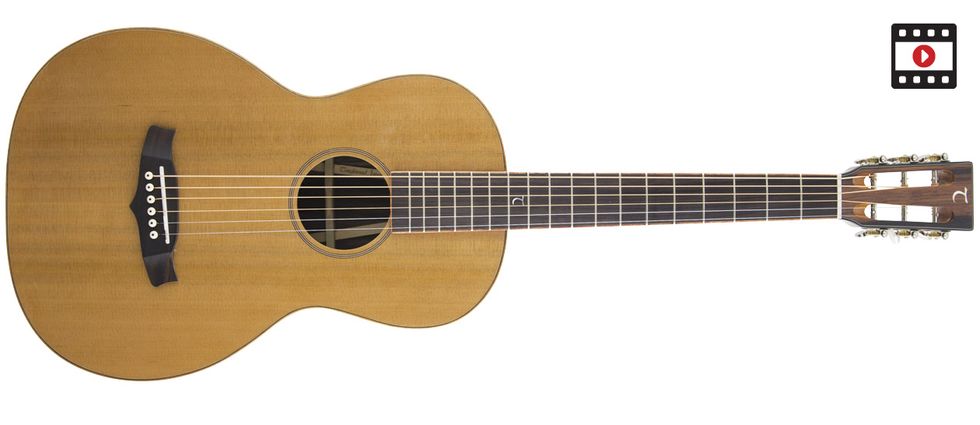
If you’ve never played a parlor guitar like the Tanglewood Java TWJP, you’ll likely be struck by how small, narrow, and super-light it feels. You might also be surprised to learn that in the 1880s, a guitar of its proportions actually would have been considered large.
By the early mid-20th century, guitar was becoming more common in live ensembles, making big, loud guitars like the dreadnought a necessity and, in time, the most popular acoustic guitar design ever. But as sound-reinforcement technology makes an acoustically loud guitar less important on stage, the tone potential of the parlor guitar has been re-examined.
There are plenty of stunning parlor options at the high end of the market by Bedell, Bourgeois, Collings, Martin, Santa Cruz, and others. Now those guitars are inspiring offerings at the opposite end of the price spectrum. The Java TWJP is a fine example of this trend. It’s designed in England and made in Indonesia, and references both 19th-century instruments and modern boutique flourishes. If you’re looking for a small, affordable acoustic that generates unique acoustic tones and textures, this cool, compact instrument might be just the ticket.
Wooden Tangents
One of the first things sharp-eyed tonewood connoisseurs will notice about the Java TWJP is the unusual selection of woods used for its back and sides. The back is built from three pieces, like a Martin D-35. But instead of a traditional tonewood, like rosewood or mahogany, the centerpiece is mango—a pale-colored wood with spalted figuring. The two outer pieces, also dramatically figured, are amara, which looks more like rosewood. Amara makes up the guitar’s sides as well.
The top is built from solid cedar, which is a fairly conventional tonewood, but one that’s more common on nylon-string guitars and boutique steel strings. And then there are the tasteful wooden flourishes that lend an organic classiness to the instrument. Instead of the usual plastic binding, Tanglewood uses mahogany binding on its body and fretboard. There’s also a mango heel cap, and the slotted headstock lends a touch of old-world elegance.
The build quality of inexpensive guitars seems to be continuously improving these days, and the Java TWJP shows how nicely built an affordable offering can be. Though the fretwork isn’t perfect—there’s a little roughness at the edges—it’s certainly neat enough. The kerfing and X-bracing appear tidily glued, and the polyurethane finish is smoothly buffed, without any obvious visual defects.
Ratings
Pros:
Solid cedar top. Nice quality for the price. Punchy output. Cool tones.
Cons:
Bass response could be better; not necessarily appropriate for heavy-handed strummers.
Tones:

Playability/Ease of Use:

Build/Design:

Value:

Street:
$379
Tanglewood Guitars Java TWJP
tanglewoodguitars.co.uk
Modern Moves
The Java TWJP is a pleasure to play, with a neck that should appeal to a wide range of players and hand sizes. The C-shaped, nato neck is of moderate girth. At 43 mm (about 1.69″), the nut width is narrower than the fashionable-for-fingerstylists 1.75″. But it definitely feels spacious and is a good fit for players transitioning from the electric guitar to the acoustic. The guitar has a plastic nut and compensated saddle, instead of the traditional and more expensive bone, but the intonation is perfectly precise. The open-geared tuners, meanwhile, manage a vintage appearance while delivering smooth, accurate, modern performance.
Moves to the Middle
Like most folks, I’m accustomed to playing a larger-bodied guitar with a more traditional tonewood mix (in my case, an Orchestra Model with an Adirondack spruce top and rosewood back and sides), so at first I was a little underwhelmed by the projection of the Java. But it certainly didn’t take long for me to appreciate its abundant charms.
The Java’s diminutive size isn’t the only factor in its unique tone makeup. Neck and body meet at the 12th-fret rather than the 14th. Most players and luthiers assert that this configuration improves bass resonance by moving the bridge closer to a sweet spot near the center of the top. And indeed the Java’s voice has a hint of warmth and sweetness that you could probably link to the 12-fret design as well as the cedar top. The low-end warmth is nice counterpoint to the guitar’s punchy midrange focus, which lends itself well to old-time fingerpicking styles like country blues and ragtime. And while the midrange is certainly the more powerful voice of the two, there is enough balance to create nice separation between notes. When I let a chord ring out, especially one that included a combination of fretted notes and open strings, I was impressed with the sustain and detail.
The Verdict
There are some inherent drawbacks that come with a guitar the size of the the Java TWJP—at least if you’re accustomed to the power of a dreadnought or orchestra model. Heavy strumming with a pick can induce a midrange-y wash (though it’s easy to imagine this sound making a cool rhythm track for more boisterous roots rock, country blues, or even gypsy jazz). And for many players, the lack of bass output will sound foreign and feel odd. But whether you’re new to the acoustic guitar or seeking more uncommon acoustic tones, Tanglewood’s Java TWJP has a lot to recommend itself. It pairs an old-school voice with modern reliability and build quality, and it’s a whole lot of fun to play. If you can work the lack of low-end punch into your sound, this little guitar can open up a world of unique and distinctive acoustic colors.
[“Source-premierguitar”]


